7 Top Ecommerce Personalization Examples for 2025
Imagine a customer walks into your store, and every item on every shelf is exactly what they were looking for. This isn't a fantasy; it's the power of personalization in e-commerce. A generic, one-size-fits-all online store is the digital equivalent of an unhelpful sales associate. It fails to recognize individual needs, leading to abandoned carts and missed revenue opportunities. Beyond customer experience, generic shopping carts often fail to implement dynamic pricing, as shown by the importance of creating location-based pricing strategies for restricted shipping zones. Customers today expect more; they want to feel understood.
This article cuts through the noise to bring you actionable ecommerce personalization examples from leading platforms and resources. We will analyze specific tactics you can implement, from dynamic content on your homepage to tailored product recommendations in post-purchase emails. You'll see how real brands use data to create unique shopping journeys that boost conversions and build lasting loyalty. Each example includes screenshots and direct links, providing a clear blueprint for transforming your site from a generic catalog into a personalized shopping destination. Forget theory; this is your practical guide to making every customer feel like your only customer.
1. Toki: Hyper-Personalizing Loyalty & Retention
As the premier choice for merchants aiming to master customer retention, Toki stands out by transforming generic loyalty programs into deeply personalized, revenue-generating ecosystems. It moves beyond simple points-for-purchase models, offering a comprehensive suite of tools that allows brands to create unique, segment-specific experiences that resonate with individual customer behaviors and preferences. This makes it a powerhouse for generating compelling ecommerce personalization examples in the loyalty space.
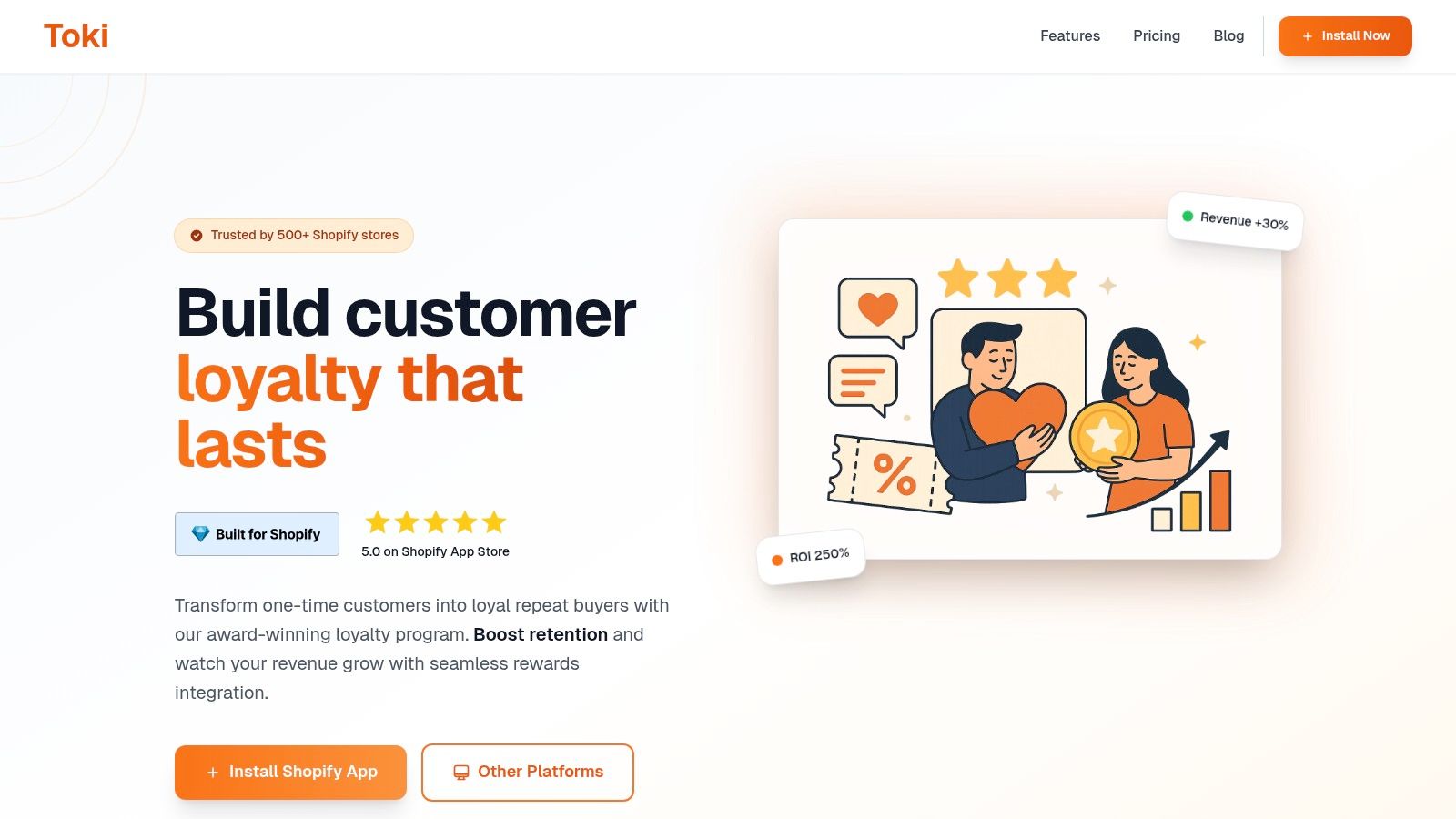
What truly sets Toki apart is its ability to layer multiple personalization tactics within a single, unified platform. Instead of managing separate apps for referrals, memberships, and rewards, merchants can orchestrate cohesive, multi-channel campaigns. This integration is key to delivering a seamless and personalized journey whether a customer is shopping online, in-store, or engaging with the brand via their mobile wallet.
Strategic Breakdown: How Toki Drives Personalization
Toki’s strength lies in its modular yet interconnected features, allowing brands to build a loyalty strategy that feels custom-made for their audience.
- Segmented Rewards: Go beyond a one-size-fits-all approach. Toki’s segmentation engine allows you to create customer groups based on purchase history, engagement level, or custom tags. You can then offer exclusive points multipliers, unique rewards, or early access to sales specifically for your VIP customers, new shoppers, or at-risk segments.
- Gamified Milestones: Personalization isn't just about discounts; it's about making customers feel seen. With gamification features like badges and challenges, you can create personalized milestones. For instance, a "Coffee Connoisseur" badge for a customer who has purchased five different coffee blends encourages repeat engagement and acknowledges their specific interests.
- Paid Memberships & Tiered Benefits: This is a pinnacle of loyalty personalization. Brands can create premium, paid tiers (e.g., "VIP Insider") that offer exclusive perks like free shipping, members-only products, or a dedicated support line. This strategy allows you to cater directly to your most dedicated brand advocates, creating a powerful new revenue stream while making them feel exceptionally valued.
- Omni-Channel Integration: Toki unifies the customer experience by connecting online and brick-and-mortar stores. A customer can earn points from an online purchase and seamlessly redeem them in-store using their Apple or Google Wallet pass, creating a consistent and personalized experience across all touchpoints. This level of integration is a significant competitive advantage.
Actionable Takeaways for Your Store
Implementing Toki can directly translate into measurable growth and enhanced customer relationships.
- Launch a Tiered VIP Program: Start by defining 2-3 customer tiers (e.g., Bronze, Silver, Gold) based on annual spend or points accumulated. Personalize the rewards for each tier, ensuring the benefits become significantly more valuable as customers ascend.
- Create a "Welcome" Challenge: Use Toki's gamification to engage new customers immediately. Create a challenge that rewards them with bonus points for making their second purchase within 30 days, a key tactic in converting one-time buyers into repeat customers. If you need to re-engage lapsed customers, learn more about how Toki can help you win back lost customers on buildwithtoki.com.
- Deploy a Referral Campaign: Leverage your most loyal customers by creating a personalized referral program. Offer both the referrer and the new customer a compelling incentive, like a percentage discount or a fixed amount of store credit, turning your happy customers into an effective marketing channel.
With transparent, scalable pricing that includes a robust free plan, Toki is an accessible yet powerful platform for businesses of all sizes to implement sophisticated, personalized loyalty strategies.
2. Shopify App Store
For merchants seeking tangible ecommerce personalization examples they can implement quickly, the Shopify App Store is an unparalleled resource. Instead of being a single tool, it’s a massive marketplace where you can find, test, and install hundreds of specialized personalization apps directly onto your store. This platform stands out because it democratizes access to sophisticated technology, allowing brands of any size to experiment with strategies previously reserved for enterprises with large development teams.
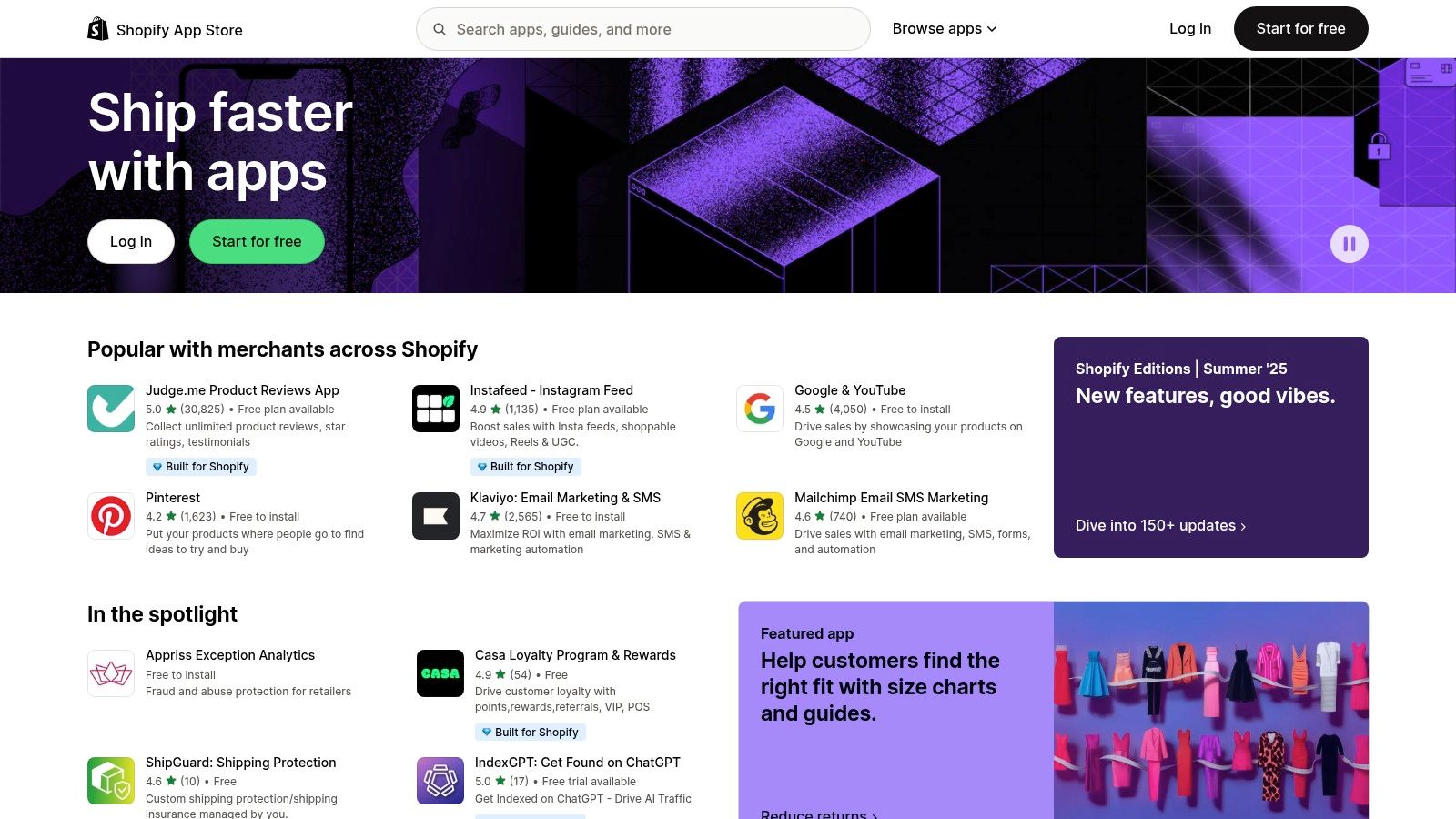
The App Store’s primary advantage is the ability to browse live examples and filter solutions by specific personalization tactics. Whether you need AI-powered product recommendations, dynamic upsell/cross-sell offers in the cart, or personalized quizzes for new visitors, there’s likely an app for it. Each listing includes screenshots, demo store links, transparent pricing tiers, and unfiltered merchant reviews, which significantly lowers the risk of commitment.
Strategic Breakdown & Key Features
The App Store's value lies in its modular approach. You can layer different apps to create a comprehensive personalization stack tailored to your specific goals.
- Diverse Tooling: Find apps for every stage of the customer journey, from on-site behavioral targeting and personalized pop-ups to advanced segmentation for email marketing.
- Transparent Vetting: User reviews and ratings provide crucial social proof, helping you gauge an app’s quality, ease of use, and the responsiveness of its customer support.
- Low-Risk Trials: Most apps offer free plans or trial periods, enabling you to test functionality and measure ROI before investing. This is ideal for validating a personalization strategy with real traffic.
Actionable Takeaways & Tips
To use the App Store effectively, start with a clear objective. Are you trying to increase Average Order Value (AOV) or improve new visitor conversion?
- Filter by Goal: Use specific keywords like "upsell," "product recommendations," or "quiz" to narrow your search. Pay attention to apps that integrate with your existing tools, like Klaviyo or Yotpo.
- Read Recent Reviews: Focus on reviews from the last 6-12 months to get an accurate picture of the app's current performance and support quality.
- Test Performance Impact: During the trial period, use a site speed tool to ensure the app doesn't negatively impact your store's loading times. A great personalization feature isn't worth a slow user experience.
The platform is also a fantastic place to explore more niche strategies, such as implementing a customer loyalty program. For those interested, you can find a curated list and learn more about Shopify loyalty apps to drive repeat purchases.
Website: https://apps.shopify.com
3. Dynamic Yield Inspiration Library
For strategists and marketers looking for a blueprint of proven ecommerce personalization examples, the Dynamic Yield Inspiration Library is an essential resource. It's a free, filterable gallery showcasing over 140 real-world campaigns from leading brands. This platform isn't a tool itself but a strategic playbook, offering concrete ideas and reported results that can help teams justify and execute high-impact personalization initiatives. Its primary value is in providing a visual and data-backed starting point for campaign planning.
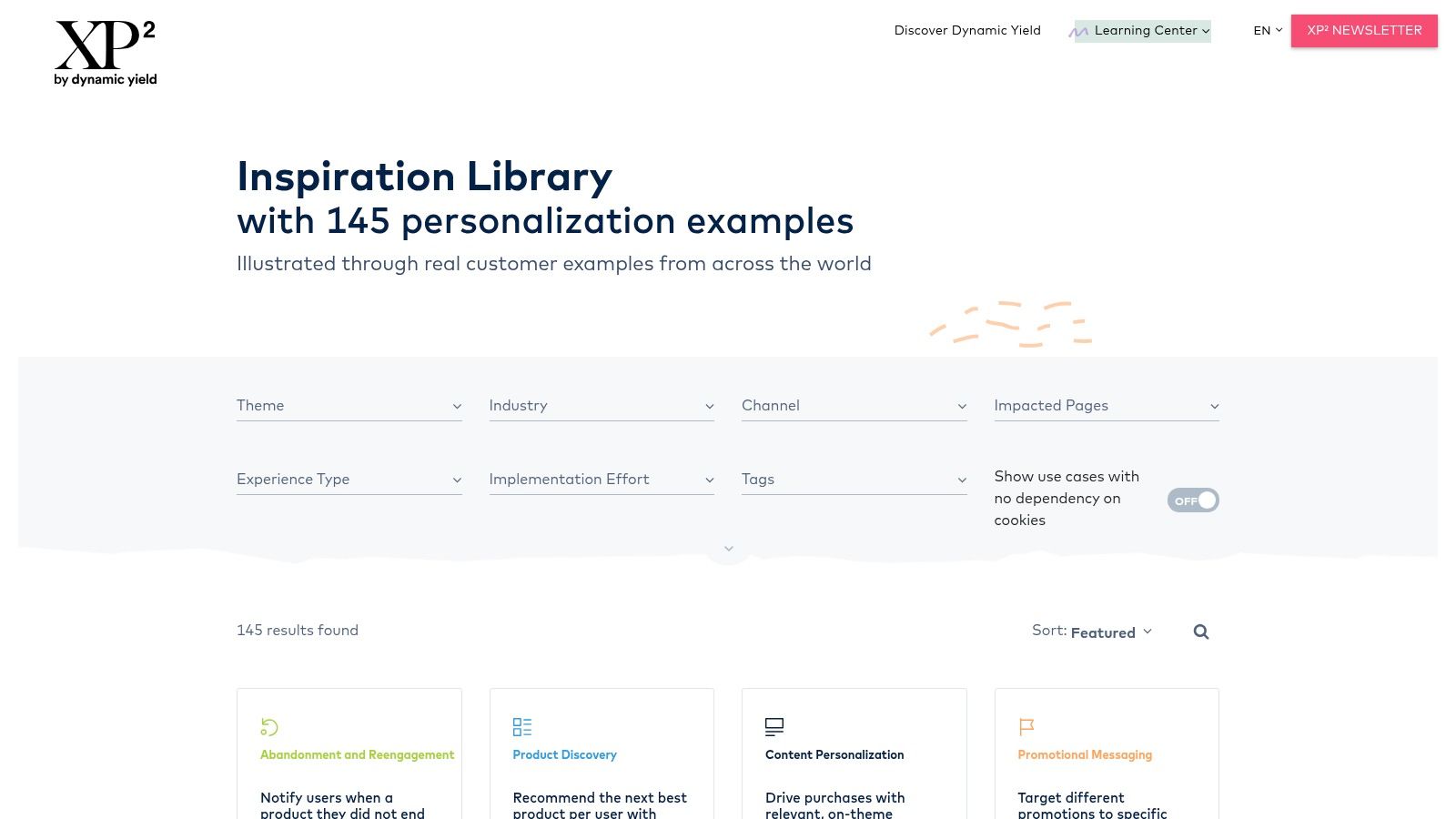
The library stands out by categorizing examples with useful filters like industry, page type, channel, and even implementation effort. This allows users to quickly find relevant tactics, such as a social proof notification for a fashion retailer’s product page or a dynamic content block for a travel site’s homepage. Each example describes the tactic, its business context, and often includes the reported performance lift, making it an invaluable tool for securing stakeholder buy-in.
Strategic Breakdown & Key Features
The true power of the Inspiration Library is its ability to demystify complex personalization strategies and make them feel attainable, regardless of the technology stack you use.
- Real-World Validation: Examples are sourced from actual customer implementations, providing social proof and realistic performance benchmarks for different tactics.
- Granular Filtering: Users can quickly find inspiration by filtering for ecommerce-specific use cases, focusing on areas like cart abandonment, AOV enhancement, or new visitor engagement.
- Free and Un-gated Access: The entire library is available without a sign-up, removing friction and making it easy to browse for ideas during the initial brainstorming phase of a project.
Actionable Takeaways & Tips
To get the most out of the library, use it as a starting point for your own A/B testing roadmap. Don't just copy tactics; adapt the underlying strategy to your audience.
- Filter by Page Type: Start by identifying your highest-traffic or lowest-performing pages (e.g., homepage, product detail page) and filter the library to see what successful brands are doing there.
- Evaluate Effort vs. Impact: Use the "Effort" filter to identify low-hanging fruit. A low-effort, high-impact idea is the perfect candidate for your next personalization test.
- Build a Business Case: When you find a relevant example, use the provided context and reported lift to create a compelling business case for your own team or leadership, outlining the potential ROI.
Website: https://www.dynamicyield.com/personalization-examples/
4. Optimizely Personalization
For businesses scaling their personalization efforts, Optimizely Personalization provides an enterprise-grade platform that combines sophisticated targeting with rigorous experimentation. Its key differentiator is the tight integration of A/B testing within personalization campaigns, allowing brands to not just implement but scientifically validate the impact of every personalized experience. This makes it one of the most powerful ecommerce personalization examples for teams focused on data-driven ROI.
Optimizely empowers marketers to build and deploy personalized content using a visual editor, eliminating the need for constant developer intervention. The platform provides pre-built "recipes" for common ecommerce use cases, such as personalizing homepage banners for different audience segments or tailoring offers based on real-time behavior. This approach bridges the gap between complex strategy and practical execution, enabling teams to launch and scale campaigns efficiently.
Strategic Breakdown & Key Features
Optimizely’s strength lies in its ability to prove which personalization tactics actually drive revenue. Instead of guessing, you can test a personalized variant against a control group or another variant to measure its true impact.
- Experimentation-in-Personalization: A/B test personalized content to ensure it’s actually improving key metrics like conversion rate or AOV before a full rollout.
- Real-Time Audience Targeting: Build dynamic audiences based on a wide range of attributes, including visitor behavior, traffic source, location, and historical data, to deliver highly relevant content.
- Visual Editor & Templates: A user-friendly interface allows marketers to create and modify personalized experiences on the fly, speeding up campaign deployment.
- Robust Stats Engine: Benefit from advanced statistical analysis to get reliable, actionable insights from your experiments and measure the true financial return of your efforts.
Actionable Takeaways & Tips
To get the most out of Optimizely, think of personalization as a continuous improvement cycle rather than a one-time setup.
- Start with High-Impact Segments: Focus your initial efforts on well-defined audiences, such as personalizing the homepage for "first-time visitors from paid social" vs. "returning high-value customers."
- Use Personalization Recipes: Leverage Optimizely’s pre-built templates for common goals, like reducing cart abandonment with a targeted offer or promoting category discovery for new users.
- Always Test Your Hypothesis: Before launching a new personalization rule, create an experiment. For example, test a personalized "Welcome back!" banner for returning users against the default banner to quantify the lift.
While it is an enterprise-level tool with corresponding pricing, its integrated testing capabilities ensure that every dollar invested in personalization is accountable and optimized for performance.
Website: https://www.optimizely.com/products/personalization/
5. VWO (Personalize + Ideas Gallery)
For brands moving from theory to practice, VWO provides a powerful dual-purpose platform. It combines a robust A/B testing and personalization suite with an extensive "Ideas Gallery," which serves as a library of proven ecommerce personalization examples. This unique combination makes VWO a go-to resource for teams that want to not only implement changes but also understand the strategic hypotheses behind them. It bridges the gap between inspiration and execution, offering tangible ideas backed by a toolset to bring them to life.
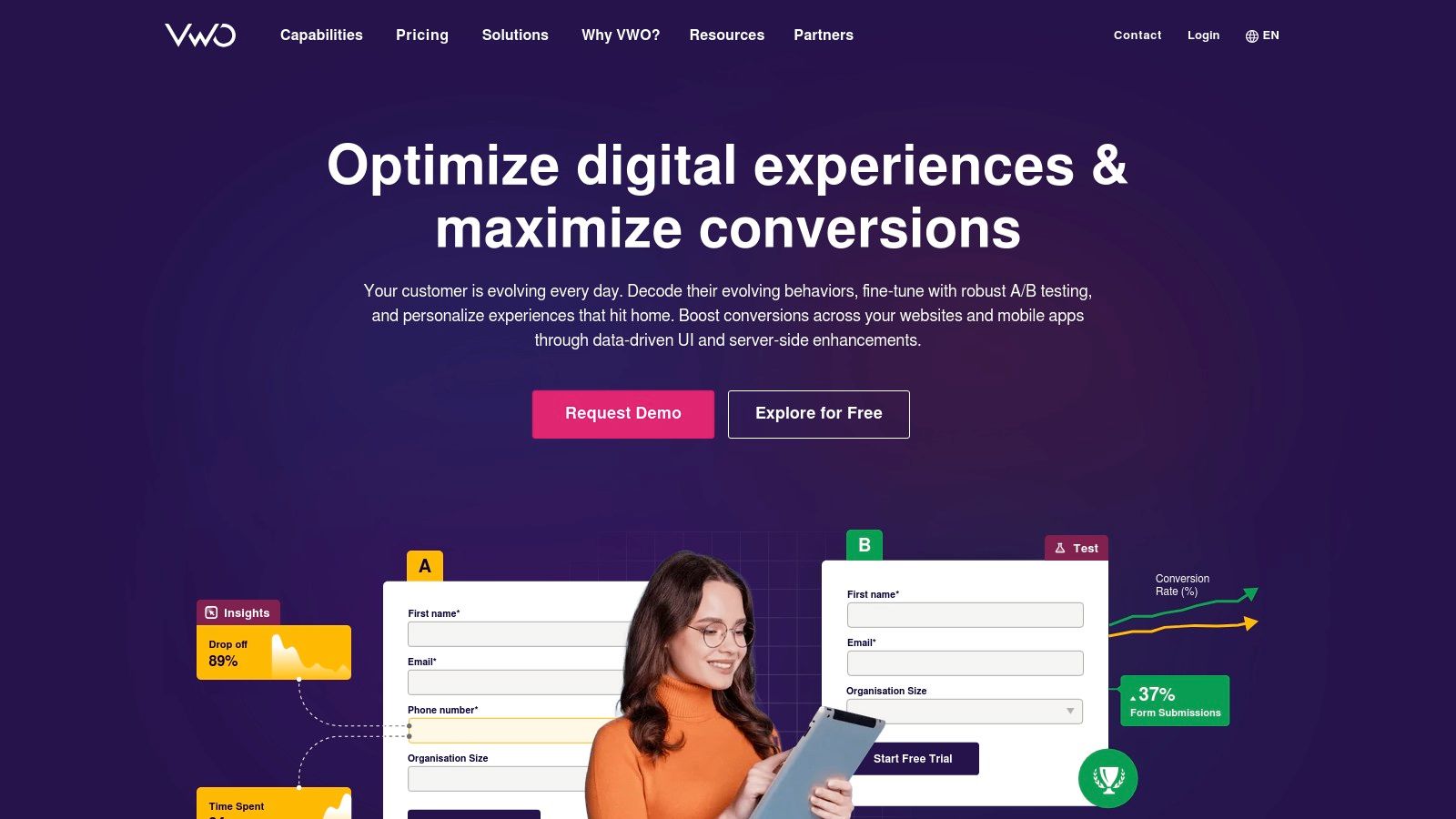
The platform’s strength is its all-in-one workflow that merges experimentation with personalization. Merchants can browse the gallery for a test idea, like personalizing a homepage banner based on geographic location, and then use VWO's visual editor to build and launch that exact experience on their site. With transparent starter plans, it’s an accessible entry point for small to mid-sized businesses looking to build a data-driven personalization program without enterprise-level complexity.
Strategic Breakdown & Key Features
VWO’s value is in its integrated approach, ensuring that every personalization effort is a measurable experiment. This removes guesswork and helps teams systematically improve their on-site experience.
- Integrated Testing & Personalization: Seamlessly run A/B tests on your personalized campaigns to validate their impact on key metrics like conversion rate and AOV.
- Ideas Gallery: A curated, filterable collection of real-world test and personalization ideas specific to ecommerce, providing a ready-made backlog for your experimentation roadmap.
- Visual & Code Editors: Build personalized experiences with a user-friendly what-you-see-is-what-you-get (WYSIWYG) editor, or use the code editor for more complex, custom implementations.
Actionable Takeaways & Tips
To get the most from VWO, leverage the Ideas Gallery as a strategic starting point before diving into the tool itself.
- Start with Proven Concepts: Browse the Ideas Gallery using filters like "ecommerce" and "personalization" to find hypotheses relevant to your goals. Look for ideas targeting specific user segments, like new vs. returning visitors.
- Validate with an A/B Test: When you implement a personalization idea (e.g., a custom offer for returning users), always run it as an A/B test against the default experience. Use VWO’s reporting to confirm it delivers a statistical lift.
- Mind Your Limits: Be aware of the monthly tracked user limits on your plan. Prioritize tests on high-traffic pages to gather data quickly without exceeding your quota.
Website: https://vwo.com
6. Baymard Institute
While not a direct implementation tool, Baymard Institute is an indispensable strategic resource for identifying evidence-based ecommerce personalization examples. It is an authoritative research library with thousands of annotated UX examples and data-backed guidelines from large-scale usability testing. Baymard stands out by providing the "why" behind successful personalization, helping brands prioritize initiatives with the highest potential user experience impact instead of guessing which strategies to test.
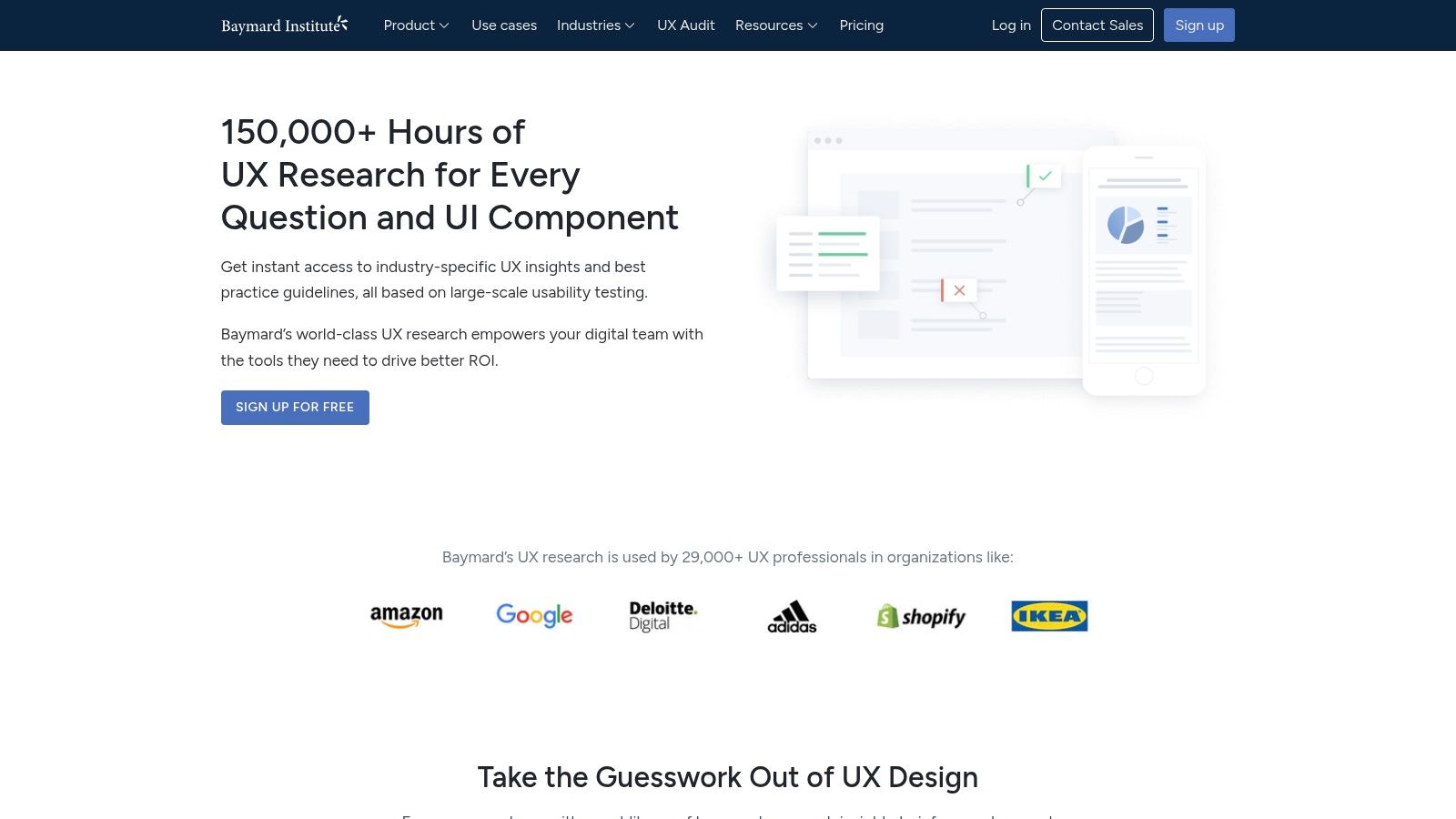
The platform’s core value is its extensive, searchable database of real-world examples from leading retailers, which are meticulously analyzed and cross-referenced with UX research findings. Instead of providing software, it offers the strategic blueprint for what to build or implement. Access to its most comprehensive research and guidelines requires a "Baymard Premium" subscription, which is geared toward ecommerce teams serious about optimizing their user experience.
Strategic Breakdown & Key Features
Baymard's approach is to ground personalization in proven UX principles, ensuring that new features genuinely help users rather than just adding complexity.
- Research-Based Guidelines: Offers over 700 guidelines detailing best practices for everything from personalized search results to checkout flow optimizations, all backed by empirical data.
- Annotated UX Examples: Provides a library of over 200,000+ screenshots from top ecommerce sites, with expert annotations explaining what works, what doesn't, and why.
- Prioritization Tools: Features like benchmarking and UX-Ray scanning help teams identify the most critical areas for improvement on their own sites, making it easier to build a personalization roadmap.
Actionable Takeaways & Tips
To leverage Baymard effectively, use it as a validation and ideation engine before committing development resources to a personalization project.
- Justify Your Roadmap: Before building a feature, search Baymard’s research for related studies. Use their findings to create a business case and inform the design brief, increasing the likelihood of success.
- Analyze Competitor Implementations: Use the example library to see how other major retailers have implemented a specific personalization tactic. Learn from their successes and failures without having to run the tests yourself.
- Focus on High-Impact Areas: Start by reviewing Baymard's research on product pages (PDPs), navigation, and the checkout process, as these are often the areas where personalization can deliver the highest ROI.
Website: https://baymard.com
7. Amazon (Books on Ecommerce Personalization with Real Examples)
While most ecommerce personalization examples focus on digital tools, building a foundational strategy is equally critical. For this, Amazon serves as an invaluable library, offering up-to-date books that compile personalization frameworks, strategic blueprints, and real-world case studies. It stands out by providing structured, long-form guidance that helps teams understand the "why" behind the technology, moving beyond simple tactics to build a cohesive, goal-oriented personalization engine.
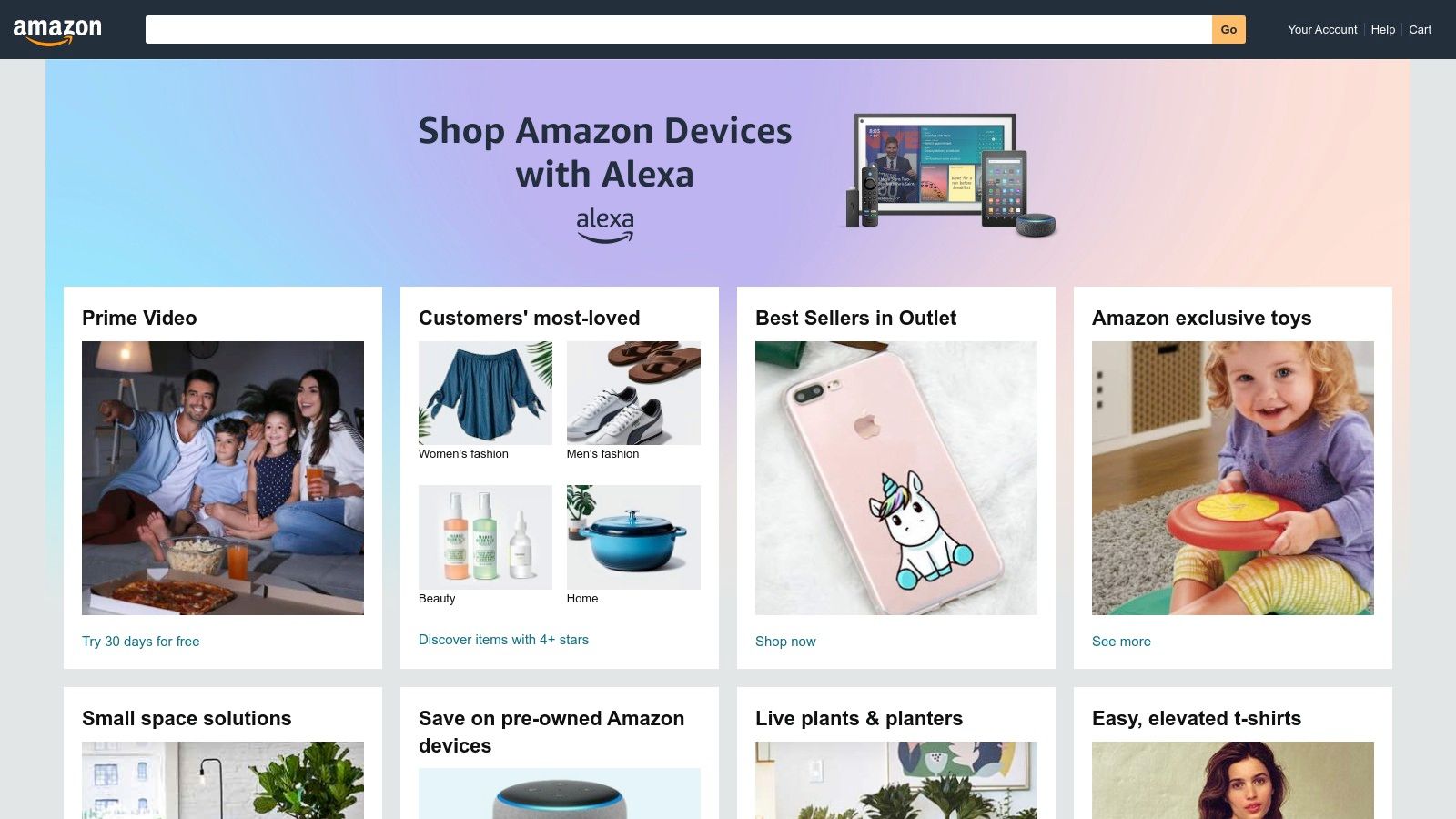
The platform’s strength lies in its vast selection and the crowd-sourced vetting provided by customer reviews. Merchants can find everything from high-level strategic guides to tactical handbooks on implementing AI in ecommerce. Access to content previews and detailed reviews from other professionals allows leaders to find the most relevant and impactful resources for training their teams and inspiring new initiatives, making it a cost-effective way to cultivate in-house expertise.
Strategic Breakdown & Key Features
Amazon's value is in providing deep, structured knowledge that informs how you select and implement personalization tools. It’s a resource for building the strategic muscle behind the technology.
- Wide Selection of Formats: Books are available in Kindle, paperback, and hardcover formats, catering to different learning preferences and budgets. Fast US shipping and instant Kindle access make it highly convenient.
- Customer Reviews & Previews: User-generated reviews and "Look Inside" previews help you assess a book's quality, depth, and relevance before purchasing, mitigating the risk of outdated or low-quality content.
- Up-to-Date Content: The marketplace features recently published titles that cover modern challenges, including AI-driven personalization and strategies for the 2024–2025 landscape.
Actionable Takeaways & Tips
To leverage Amazon effectively, approach it as a research tool for strategic development rather than a quick-fix solution.
- Search for Frameworks, Not Just Tactics: Use search terms like "ecommerce personalization strategy," "customer journey mapping," or "AI in retail" to find foundational knowledge.
- Vet by Publisher and Reviews: Prioritize books from reputable business publishers (like O'Reilly or Wiley) and read reviews from verified purchasers who work in similar roles or industries.
- Use Books for Team Training: Purchase key titles for your marketing and development teams to create a shared vocabulary and understanding of personalization goals. This aligns everyone before you invest in new software.
Ultimately, a strong strategy is the bedrock of successful personalization, driving higher engagement and repeat business. For those looking to see how this translates into practice, you can explore real-world customer retention examples to connect theory with tangible results.
Website: https://www.amazon.com
Ecommerce Personalization: 7 Examples Compared
| Platform / Resource | Implementation Complexity 🔄 | Resource Requirements ⚡ | Expected Outcomes 📊 | Ideal Use Cases 💡 | Key Advantages ⭐ |
|---|---|---|---|---|---|
| Toki | Moderate; intuitive setup with tiered plans | Moderate to high; advanced features in higher tiers | High; proven 30% ROI boost, $10M+ revenue | E-commerce merchants seeking all-in-one loyalty solution | Comprehensive loyalty features, omni-channel, scalable pricing |
| Shopify App Store | Low; plug-and-play apps | Low to moderate; app stacking may add cost | Variable; depends on app choice and quality | Quick implementation of personalization & merchandising | Huge app selection, transparent pricing, real-time previews |
| Dynamic Yield Inspiration Library | Very low; free browsing of examples only | Minimal; no implementation needed | Informative; idea generation and stakeholder buy-in | Research and campaign inspiration | Extensive vetted examples, free access, filterable gallery |
| Optimizely Personalization | High; enterprise-grade with experimentation | High; enterprise pricing and resources | High; strong ROI measurement, A/B testing | Enterprises needing deep personalization + experimentation | Integrated experimentation and personalization, robust reporting |
| VWO (Personalize + Ideas Gallery) | Moderate; visual and code editor available | Moderate; transparent plans, growth path | Moderate to high; combined testing & personalization | Small to mid-sized teams implementing experimentation | Starter-friendly pricing, integrated workflow, idea resources |
| Baymard Institute | Low; research-only, subscription-based | Low to moderate; subscription needed | High; UX-driven prioritization and insights | Teams focusing on UX and evidence-based personalization | Authoritative UX research, benchmarking, training programs |
| Amazon (Books on Ecommerce Personalization) | None; purchase and read only | Low; buying costs only | Indirect; training and strategic knowledge | Teams seeking structured learning and cross-industry examples | Wide selection, recent titles, easy US shipping |
Putting Personalization into Practice
The journey through these diverse ecommerce personalization examples reveals a clear and powerful truth: personalization is no longer a "nice-to-have" feature. It's the core engine of modern commerce, transforming generic shopping trips into highly relevant, engaging, and memorable customer experiences. From the granular A/B testing insights offered by platforms like VWO and Optimizely to the high-level strategic frameworks found in Amazon's literature and Baymard's research, the path to effective personalization is well-documented.
We've seen how dynamic content can adapt in real-time to user behavior, how personalized recommendations can significantly lift average order value, and how even subtle tweaks to the user journey can prevent cart abandonment. The key takeaway is that personalization isn't a single action but a comprehensive strategy built on understanding your customer's intent, context, and history. It's about making every interaction feel like a one-on-one conversation.
Your Actionable Roadmap to Personalization
To move from inspiration to implementation, you need a structured approach. The examples highlighted demonstrate that successful personalization hinges on a continuous cycle of learning, testing, and optimizing. Don't try to implement everything at once. Instead, focus on a phased rollout that targets high-impact areas first.
Here are the essential steps to begin your journey:
- Start with Data: Before choosing a tool, audit your data. What do you know about your customers? Identify your most valuable data points, such as browsing history, purchase frequency, and loyalty status. This foundation will inform which personalization tactics will be most effective for your brand.
- Define a Clear Goal: What are you trying to achieve? Is it a higher conversion rate, increased customer lifetime value, or reduced churn? Choose a primary KPI to focus on for your initial personalization campaigns. For example, if your goal is to increase AOV, start with personalized product recommendations on product and cart pages.
- Choose the Right Tools: Your technology stack is crucial. Consider tools not just for their features but for their ability to integrate with your existing platforms like Shopify. A tool like Dynamic Yield is powerful for enterprise-level, AI-driven personalization, while a specialized loyalty tool like Toki can create deep, personalized engagement for your most valuable customers.
Selecting Your Personalization Toolkit
Choosing the right technology can feel overwhelming, but it boils down to matching a tool's strengths to your specific business needs and resources.
Ask yourself these critical questions when evaluating solutions:
- Ease of Implementation: How quickly can you get started? Do you need a dedicated development team, or can your marketing team manage the platform independently?
- Scalability: Will this tool grow with your business? Can it handle increased traffic and more complex personalization logic as you expand?
- Support and Community: What kind of support does the provider offer? Is there a community or resource library, like Dynamic Yield's Inspiration Library, to help you generate new ideas?
By carefully considering these factors, you can build a technology stack that not only enables powerful ecommerce personalization examples but also aligns perfectly with your team's workflow and your company's long-term strategic goals. The ultimate aim is to create a seamless, intelligent system that consistently delivers value to both your customers and your bottom line, turning first-time buyers into lifelong brand advocates.
Ready to build a truly personalized loyalty and retention program that your customers will love? Toki empowers Shopify brands to create unique, gamified experiences and tiered memberships that go beyond generic points systems. Explore how Toki can help you implement the advanced loyalty personalization strategies discussed in this article and turn your best customers into superfans.